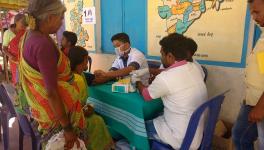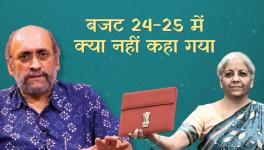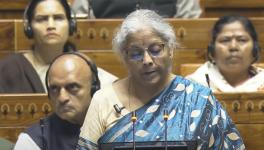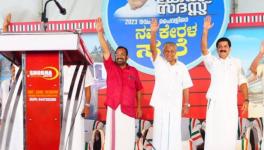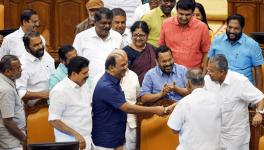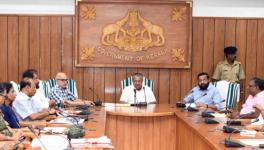Budget 2021-22: Govt Fails to Strengthen Public Healthcare
The Union Budget 2021-22, presented by the Finance Minister of India on February 1, managed to excite the gallery by giving catchy headlines. A 137% increase in Health and Wellbeing budget outlay! The excitement was short-lived as the word and number play in the budget speech was soon deciphered.
In reality, the budget for the health sector has increased from Rs. 69,234 crore in 2020-21 BE to Rs. 76,902 crore in 2021-22 BE – an increase of a meagre Rs. 7,668 crore. It was expected that healthcare will take the centre stage, finally – as highlighted by the Economic Survey 2020-21, but alas!
In 2020-21 BE, the Union government allocations on health were as low as 0.31% of Gross Domestic Product (GDP). In 2021-22 BE this has increased marginally to 0.35% of GDP. To increase public health spending to 2.5% of GDP by 2025, as envisaged in the National Health Policy 2017, the Union Government allocations towards health need to be increased much more than this.
Under National Health Mission (NHM), the allocations in 2021-22 BE have increased by Rs. 3,175 crore over 2020-21 BE which is a positive step as last year NHM had seen budget cuts. Most of this increase has been focused on National Rural Health Mission (NRHM) and the urban counterpart, National Urban Health Mission (NUHM), has not received much attention. Some of the key schemes such as Reproductive and Child Health (RCH) and Health and Wellness Centres (HWCs) which are important interventions under primary healthcare, have seen only marginal increase over last year’s budget:
-
RCH Flexible Pool including Routine Immunisation Programme, Pulse Polio Immunisation Programme, National Iodine Deficiency Disorders Control Programme etc. (increase by Rs. 388 crore)
-
Ayushman Bharat - Health and Wellness Centres (by Rs. 300 crore)
India needs a much larger intervention to improve primary healthcare and both RCH and HWCs are key components to deliver this. These need to be strengthened further. Last year saw severe disruptions in delivering basic public health services such as immunisation and other reproductive and child care services.
A substantial portion of increase in NRHM has been in the component of Health System Strengthening (by Rs. 2183 crore), but Human Resources for Health and Medical Education has received only a meagre increase (by Rs. 114 crore).
Under the Pradhan Mantri Swasthya Suraksha Yojana, which is meant for setting up AIIMS and upgradation of existing government medical college institutions, there is an increase of Rs. 980 crore but it must be noted that the completion of AIIMS in several cities is moving at a tardy pace with several structures and facilities still incomplete. Some components allocations for which budget should have been enhanced such as “Health Sector Disaster Preparedness and Response and Human Resources Development for Emergency Medical Services”, allocations have actually stagnated.
Reduction in Allocations for Nutrition
Recently released National Family Health Survey-5 (NFHS 5) report reveals an alarming situation with respect to nutritional status of women and children. Observations from the report show that among the 17 states, some states have one-third to nearly half of young children (up to 5 years of age) suffering from symptoms due to chronic lack of healthy food - low weight, stunting and wasting. Around half to over three-fourth of children, and one-third to three-fourth of women in the reproductive age (15-49 years) suffer from anaemia.
In the light of this report, the government should have paid attention to the nutritional needs and increased provisions under key nutritional schemes. Under the Mid-day Meal scheme (or MDM, which coms under Department of School Education and Literacy) there has been only a nominal increase of Rs. 500 crore over last year’s allocation. MDM is one of the most important interventions to enhance enrolment, retention and attendance and simultaneously improving nutritional levels among children and covers all children from class I to VIII across the country.
A disaggregated analysis under Demand No. 100 pertaining to Ministry of Women and Child Development (MWCD) shows that there is a decline in allocations for some of the key schemes focusing on women. Many of the schemes have been clubbed together under three different heads - Saksham Anganwadi and POSHAN 2.0, Mission Vatsalaya, and Mission Shakti. This clubbing has masked the decline in specific schemes. Tables below give the break-up of the components of the newly clubbed schemes and compares the current year allocation to the previous year under these schemes.
If one compares the 2021-22 BE allocations for the new composite schemes such as the Saksham Anganwadi and POSHAN 2.0 and the SAMARTHYA schemes with the allocations for the constituent schemes in 2020-21 BE, there is a decline in the current year allocations.
Table 1.1: Comparative allocations in 2020-21 and 2021-22: Saksham Anganwadi & POSHAN 2.0 and constituent schemes (in Rs. Crore)
| Schemes | 2020-21 BE | 2021-22 BE |
|---|---|---|
| 1. Anganwadi Services | 20,532 | - |
| 2. Poshan Abhiyan | 3,700 | - |
| 3. Scheme for Adolescent Girls | 250 | - |
| 4. National Creche Scheme | 75 | - |
| Total (1 to 4) | 24,557 | - |
| Saksham Anganwadi and POSHAN 2.0 (Umbrella ICDS – Anganwadi Services, Poshan Abhiyan, Scheme for Adolescent Girls, National Creche Scheme) | - | 20,105 |
Source: Union Budget documents, 2021-22
Table 1.2: Comparative allocations in 2020-21 and 2021-22: SAMARTHYA and constituent schemes (in Rs. Crore)
Source: Union Budget documents, 2021-22
The Arithmetic of the 137% Increase
According to the FM, the increase under Health and Wellbeing has increased from Rs. 94,452 crore to Rs. 2,23,846 crore. As has been pointed out by a number of reports, this is more of an act of deception. The avowed hike is misleading as the figure include –
-
budget allocation under Department of Drinking Water and Sanitation (D/o W & S)
-
budget allocation under Poshan Abhiyan (or National Nutrition Mission) under MWCD
-
Finance Commission (FC) Grants for Drinking Water and Sanitation and Health. The amount of Rs. 13,192 under FC grant for health is the grant to rural and urban local bodies for primary health sector for the year 2021-22.
-
grant for Covid Vaccine
It was an interesting trick on the part of the FM to club all these allocations and give an impression that this is the expenditure on health. The FC grants to local bodies cannot be included the Union Government’s budget. A proposed grant of Rs. 35,000 crore for Covid-19 vaccine in 2021-22 BE is a welcome step. But, just as FC grants, this is also a one-time grant and not included in the regular budget.
However, what is unprecedented is the hike in Jal Jeevan Mission (JJM) under the D/o W & S – Rs. 38,540 crore! This perhaps would be the biggest hike ever under one scheme in one year. JJM aims at providing Functional Household Tap Connection to every rural household by 2024. It begs the question whether this been done keeping in mind the upcoming election season.
Modalities of the New CSS - PM Atma Nirbhar Swasth Bharat Yojana?
In addition to the budget, a new centrally sponsored scheme (CSS), PM Atma Nirbhar Swasth Bharat Yojana, is proposed to be launched with an outlay of about Rs. 64,180 crores. This scheme will be oriented towards developing capacities of primary, secondary, and tertiary care Health Systems, strengthening existing national institutions, and creating new institutions, to cater to detection and cure of new and emerging diseases. It is a welcome step as this is proposed to be in addition to the National Health Mission (NHM). However, the spread of this outlay is over a period of six years, so only a part of it will be utilised now. As this is a CSS, it is quite probable that some part of the expenditure is borne by the states. No details are given as yet on the modalities of this scheme.
One of the interventions under the scheme is “Establishing critical care hospital blocks in 602 districts and 12 central institutions”. Amulya Nidhi, a member of the Jan Swasthya Abhiyan (JSA), raises concerns over this component. According to him, “The NITI Aayog has been pushing for a public-private partnership model to link new or existing private medical colleges with functional district hospital. If this particular component of PM Atma Nirbhar Swasth Bharat Yojana is trying to push that agenda then it is problematic”. JSA and other groups have opposed such a move arguing that “…this scheme is drawn up as an avenue for corporate investment and profits in health care” and that “…the government is looking at public health services as a source of revenue rather than as the fulfilment of commitments of a welfare state”.
Continuation of PMJAY Despite Its Failure During Covid-19 Emergency
There has been no change in the budgetary allocation for the much-eulogised scheme by the Pradhan Mantri Jan Aarogya Yojana (PMJAY). In the revised estimates for 2020-21, only Rs. 3,100 crore could be utilised under the scheme. Despite this, the allocation for PMJAY is maintained at Rs. 6,400 crore as in the last budget. As per the budget document, this is being financed through Pradhan Mantri Swasthya Suraksha Nidhi (PMSSN). There are no details given about the PMSSN. However, this needs to be seen in the light of recent reports that the government was planning to launch a Pradhan Mantri Swasthya Samvardhan Nidhi that was proposed as a non-lapsable fund in the Public Account, which would include collections under the health and education cess.
Moreover, the PMJAY has been a controversial insurance scheme. It is a government funded scheme to cover secondary and tertiary-level inpatient expenses for poor families, and it essentially promotes earnings for private hospitals. During the Covid-19 public health emergency, PMJAY has not been able to deliver services to the poor. There was a 51% decline in average weekly claim volume during the 10-week lockdown period (March 25 to June 2, 2020).
The Union Budget 2021-22 has exposed the ruling dispensation further. In such crucial areas as health and employment guarantee through MGREGA, two of the most important areas in the context of the distress caused by the Covid-19 pandemic, the government has tried to get away with providing little. As in most other sectors, in health too there is a consistent push towards privatisation despite evidence that robust public health system ensures better health outcomes. The pandemic had presented an opportunity to reorient the health policy towards strengthening public provisioning of healthcare and ensuring an equitable and affordable access to health for all. The government appears to have failed in leveraging it!
Get the latest reports & analysis with people's perspective on Protests, movements & deep analytical videos, discussions of the current affairs in your Telegram app. Subscribe to NewsClick's Telegram channel & get Real-Time updates on stories, as they get published on our website.










